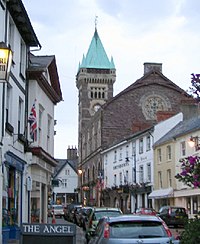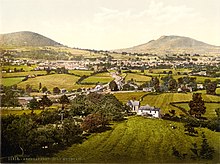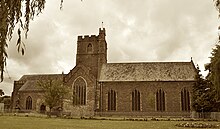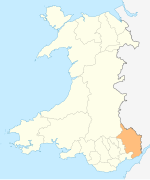Abergavenny
This article includes a list of general references, but it lacks sufficient corresponding inline citations. (July 2013) |
Abergavenny
| |
|---|---|
 Abergavenny town centre, showing the Market Hall and town hall clock tower | |
Location within Monmouthshire | |
| Population | 10,078 (2011)[1] |
| OS grid reference | SO295145 |
| Community |
|
| Principal area | |
| Preserved county | |
| Country | Wales |
| Sovereign state | United Kingdom |
| Post town | ABERGAVENNY |
| Postcode district | NP7 |
| Dialling code | 01873 |
| Police | Gwent |
| Fire | South Wales |
| Ambulance | Welsh |
| UK Parliament | |
| Senedd Cymru – Welsh Parliament | |
Abergavenny (/ˌæbərɡəˈvɛni/; Template:Lang-cy pronounced [ə ˈvɛnɪ], archaically Abergafenni meaning "Mouth of the River Gavenny") is a market town in Monmouthshire, Wales. It is located 15 miles (24 km) west of Monmouth on the A40 and A465 roads, 6 miles (10 km) from the English border. Originally the site of a Roman fort, Gobannium, it became a medieval walled town within the Welsh marches. The town contains the remains of a medieval stone castle built soon after the Norman conquest of Wales. The town hosted the 2016 National Eisteddfod of Wales.
Abergavenny is promoted as a "Gateway to Wales".[2][3] Situated at the confluence of a tributary stream, the Gavenny, and the River Usk,[4] it is almost surrounded by two mountains – the Blorenge (559 m, 1,834 ft)[5] and the Sugar Loaf (596 m, 1,955 ft)[6] – and five hills: Ysgyryd Fawr (The Skirrid), Ysgyryd Fach (Skirrid Fach), Deri, Rholben and Mynydd Llanwenarth, known locally as "Llanwenarth Breast". It provides access to the nearby Black Mountains and the Brecon Beacons National Park. The Offa's Dyke Path is close by and the Marches Way, the Beacons Way and Usk Valley Walk all pass through the town.
History
Origins of the town and its name

The name derives from a Brythonic word Gobannia meaning "river of the blacksmiths", and relates to the town's pre-Roman importance in iron smelting. The name is related to the modern Welsh word gof (blacksmith), and so is also associated with the Welsh smith Gofannon from folklore. The river later became, in Welsh, Gafenni, and the town's name became Abergavenny, meaning "mouth of (Welsh: Aber) the Gavenny (Gafenni)". In Welsh, the shortened form Y Fenni may have come into use for a very short period after about the 15th century, although pronounced similarly in English or Welsh the English spelling Abergavenny is in general use.[7]
Roman period
Gobannium was a Roman fort guarding the road along the valley of the River Usk,[4] which linked the legionary fortress of Burrium (Usk) and later Isca Augusta or Isca Silurum (Caerleon) in the south with Y Gaer, Brecon and Mid Wales. It was also built to keep the peace among the local British Iron Age tribe, the Silures.[citation needed]
Remains of the walls of this fort were discovered west of the castle when excavating the foundations for a new post office and telephone exchange building in the late 1960s.[citation needed]
11th century

Abergavenny grew as a town in early Norman times under the protection of the Lords of Abergavenny. The first Baron was Hamelin de Balun, from Ballon, a small town and castle in Maine-Anjou called "Gateway to Maine", near Le Mans, today in the Sarthe département of France. He founded the Benedictine priory, now the Priory Church of St Mary, in the late 11th century. The Priory belonged originally to the Benedictine foundation of St. Vincent Abbaye at Le Mans. It was subsequently endowed by William de Braose, with a tithe of the profits of the castle and town.[8] The church contains some unique alabaster effigies, church monuments and unique medieval wood carving, such as the Tree of Jesse.[citation needed]
12th and 13th centuries
Owing to its geographical location, the town was frequently embroiled in the border warfare and power play of the 12th and 13th centuries in the Welsh Marches. In 1175, Abergavenny Castle was the site of the Massacre.[citation needed] Reference to a market at Abergavenny is found in a charter granted to the Prior by William de Braose.[8]
15th to 17th centuries

Owain Glyndŵr attacked Abergavenny in 1404. According to popular legend, his raiders gained access to the walled town with the aid of a local woman who sympathised with the rebellion, letting a small party in via the Market Street gate at midnight. They were able to open the gate and allow a much larger party who set fire to the town and plundered its churches and homes leaving Abergavenny Castle intact. Market Street has been referred to as "Traitors' Lane" thereafter. In 1404 Abergavenny was declared its own nation by Ieuan ab Owain Glyndŵr, illegitimate son of Owain Glyndŵr. The arrangement lasted approximately two weeks.[citation needed]
At the Dissolution of the Monasteries in 1541, the priory's endowment went towards the foundation of a free grammar school, King Henry VIII Grammar School, the site itself passing to the Gunter family.[8]
During the Civil War, prior to the siege of Raglan Castle in 1645, King Charles I visited Abergavenny and presided in person over the trial of Sir Trefor Williams, 1st Baronet of Llangibby, a Royalist who changed sides, and other Parliamentarians.[8]
In 1639, Abergavenny received a charter of incorporation under the title of bailiff and burgesses. A charter with extended privileges was drafted in 1657, but appears never to have been enrolled or to have come into effect. Owing to the refusal of the chief officers of the corporation to take the oath of allegiance to William III in 1688, the charter was annulled, and the town subsequently declined in prosperity. Chapter 28 of the 1535 Act of Henry VIII, which provided that Monmouth, as county town, should return one burgess to Parliament, further stated that other ancient Monmouthshire boroughs were to contribute towards the payment of the member. In consequence of this clause Abergavenny on various occasions shared in the election, the last instance being in 1685.[8]
The right to hold two weekly markets and three yearly fairs, beginning in the 13th century, was held ever since as confirmed in 1657.{{[9] citation needed|date=July 2013}} Abergavenny was celebrated for the production of Welsh flannel, and also for the manufacture, whilst the fashion prevailed, of goats' hair periwigs.[8]
19th and 20th centuries

Abergavenny railway station opened 2 January 1854 by the Newport, Abergavenny and Hereford Railway. The London North Western Railway sponsored the construction of the railway linking Newport station to Hereford station. The line was taken over by the West Midland Railway in 1860 before becoming part of the Great Western Railway in 1863. The station is on the Welsh Marches Line and is mostly served by Arriva Trains Wales services.[citation needed] Adolf Hitler's deputy Rudolf Hess was kept under escort at Maindiff Court Military Hospital during the Second World War, after his flight to Britain.[10]
Baron of Abergavenny
The title of Baron Abergavenny, in the Nevill family, dates from the 15th century with Edward Nevill, 3rd Baron Bergavenny, who was the youngest son of Ralph de Neville, 1st Earl of Westmorland by his second wife Joan Beaufort, daughter of John of Gaunt, first Duke of Lancaster.[citation needed] He married the heiress of Richard de Beauchamp, 1st Earl of Worcester, whose father had inherited the castle and estate of Abergavenny, and was summoned in 1392 to parliament as Lord Bergavenny.[citation needed] Edward Nevill was summoned to parliament with this title in 1450.[citation needed] His direct male descendants ended in 1587 in Henry Nevill, 6th Baron Bergavenny, but a cousin, Edward Nevill, 8th Baron Bergavenny, was confirmed in the barony in 1604.[citation needed] From him it has descended continuously, through fifteen individuals, the title being increased to an earldom in 1784; and in 1876 William Nevill [sic] 5th Earl, an indefatigable and powerful supporter of the Tory Party, was created 1st Marquess of Abergavenny.[8]
Coldbrook Park was a country house in an estate some 1+1⁄4 miles (2 km) southeast of the town. The house was originally built in the 14th century and belonged to the Herbert family for many generations until purchased by John Hanbury for his son, the diplomat Sir Charles Hanbury Williams.[11] Sir Charles reconstructed the house in 1746 with the addition of a nine-bay two-storey Georgian façade with a Doric portico. It subsequently passed down in the Hanbury Williams family until it was demolished in 1954.[12]
Events
National Eisteddfod 2016
Held during the first week of August every year, the National Eisteddfod is a celebration of the culture and language in Wales. The festival travels from place to place, alternating between north and south Wales, attracting around 150,000 visitors and over 250 tradestands and stalls. The Chair and Crown for 2016 were presented to the festival's Executive Committee, at a special ceremony in Monmouth held on 14 June 2016.[13]
Other events
The Abergavenny Food Festival, is held in the second week of September each year. The Steam, Veteran and Vintage Rally takes place in May every year. The event expands year on year with the 2016 rally including a rock choir, shire horses, motorcycling stunts, vintage cars and steam engines.[14] The Country and Western Music Festival is attended by enthusiasts of country music. It marked its third year in 2016 and was attended by acts including Ben Thompson, LA Country and many more.[15] The Abergavenny Writing Festival began in April 2016 and is a celebration of writing and the written word.[16]
Welsh language
In recent decades the number of Welsh speakers in the town has increased dramatically. The 2001 census recorded 10% of the local population spoke the language, a five fold increase over ten years from the figure of 2% recorded in 1991.[17]
The town has one of the two Welsh-medium primary schools in Monmouthshire, Ysgol Gymraeg y Fenni,[18] which was founded in the early 1990s. It is also home to the Abergavenny Welsh society, Cymreigyddion y Fenni,[19] and the local Abergavenny Eisteddfod.[20]
Sporting traditions
Abergavenny was the home of Abergavenny Thursdays F.C., which was formed in 1927, but wound up in 2013. However, football is now represented in the town by the new Abergavenny Town team which was formerly called Govilon FC. Town play at the Penypound Stadium and are members of the Welsh League Division 2 for season 2016-17.
Abergavenny Cricket Club play at Pen-y-Pound, Avenue Road, and Glamorgan CCC also play some of their games here. Abergavenny Cricket Club is one of the oldest in the country and celebrated the 175th anniversary of its foundation in 2009.[citation needed] Abergavenny Tennis Club also play at Pen-y-Pound and plays in the South Wales Doubles League and Aegon Team Tennis. The club engages the services of a head tennis professional to run a coaching programme for the town and was crowned Tennis Wales' Club of the Year in 2010.[citation needed]
Abergavenny is also the home of Abergavenny RFC, a rugby union club founded in 1875 who play at Bailey Park. They play in the Welsh Rugby Union Division Two East league.[citation needed] Abergavenny Hockey Club, formed in 1897, currently compete in the Davis Woods hockey league and play at the Old Hereford Road ground.[citation needed] Abergavenny hosted the British National Cycling Championships in 2007, 2009 and 2014, as part of the town's Festival of Cycling.[21]
Markets and fairs
Cattle market
A cattle market has been held in Abergavenny on its current site since 1863.[4] During the period 1825–1863 a sheep market was held at a site in Castle Street, to stop the sale of sheep on the streets of the town. Today the market is leased and operated by Abergavenny Market Auctioneers Ltd, who hold regular livestock auctions on the site. Market days are: Tuesday – auction sale of finished sheep, cull ewe/store and fodder (hay and straw). Some Fridays – auction sale of cattle. A few other sales are held at the market on other days throughout the year. Following the closure of Newport's cattle market for redevelopment, Newport’s sales are held at Abergavenny every Wednesday.[citation needed]
In 2011, doubts about the future of Abergavenny Cattle Market were raised following the granting of planning permission by Monmouthshire County Council for its demolition and replacement with a supermarket, car park, and library.[22]
In January 2012, the Welsh Government announced the repeal the Abergavenny Improvement Acts of 1854 to 1871 which obliged the holding of a livestock market within the boundaries of Abergavenny town;[23] that repeal being effective from 26 March 2012.[24]
Monmouthshire County Council, which requested that the Abergavenny Improvement Acts be repealed, is supporting plans for a new cattle market to be established about 10 miles (16 km) from Abergavenny in countryside at Bryngwyn, some 3 miles (5 km) from Raglan. There has been extensive local opposition to this site, which is situated on a notoriously dangerous B road.[citation needed]
The Market Hall

Various markets are held in the Market Hall, for example: Tuesdays, Fridays and Saturdays – retail market; Wednesdays – flea market; fourth Thursday of each month – farmers' market; third Sunday of each month – antique fair; second Saturday of each month – craft fair.[citation needed]
Culture
This section needs additional citations for verification. (July 2013) |
- Abergavenny hosted the National Eisteddfod of Wales in 1838, 1913 and most recently in 2016
- Lord Abergavenny is a character in William Shakespeare's play Henry VIII.
- In 1968 "Abergavenny" was the title of a UK single by Marty Wilde. In 1969 it was also released in the US, under a Marty Wilde pseudonym "Shannon", where it was also a minor hit.[25]
- In 1996 a film, Intimate Relations starring Julie Walters, Rupert Graves, Les Dennis and Amanda Holden was filmed at many locations in and around Abergavenny.
- The town's local radio stations are currently Sunshine Radio, at 107.8 FM, and NH Sound 1287 AM.
- Abergavenny is twinned with Östringen in Germany, Beaupréau in France and Sarno in Italy.
- Abergavenny is home to an award winning brass band.[26] Formed in Abergavenny prior to 1884[27] the band became joint National Welsh League Champions in 2006[28] and SEWBBA[clarification needed] and again joint National Welsh League Champions in 2011.[29] The band also operate a Junior Band training local young musicians
- Sherlock Holmes refers, in The Adventure of the Priory School, to a case he's working on in Abergavenny.[30]
- In the book Harry Potter and the Prisoner of Azkaban, Abergavenny is mentioned by Stan Shunpike, the conductor of the Knight Bus when the bus takes a detour there to drop off a passenger.
- In the classic 70s period drama Upstairs, Downstairs, a major character in the second season, which is circa 1909-10, is Thomas Watkins, the devious Bellamy family chauffeur. Watkins came from Abergavenny. In the 1979 spinoff of Upstairs, Downstairs titled Thomas & Sarah, Watkins and Sarah Moffat, another major character, marry and return briefly to Abergavenny.
- The Borough Theatre in the town centre hosts live events covering drama, opera, ballet, music, children’s events, dance, comedy, storytelling, tribute bands and talks.[31]
- During September the town holds the Abergavenny Food Festival.
- Abergavenny was named one of the best places to live in Wales in 2017.[32]
Buildings of note
Abergavenny Castle is located strategically just south of the town centre overlooking the River Usk. It was built in about 1067 by the Norman baron Hamelin de Ballon to guard against incursions by the Welsh from the hills to the north and west.[33] All that remains is defensive ditches and the ruins of the stone keep, towers, and part of the curtain wall. It is a Grade I listed building.[34]

Other listed buildings in the town include the parish Church of St Mary, a medieval and Victorian building that was originally the church of the Benedictine priory founded in Abergavenny before 1100; the sixteenth century tithe barn near St Mary's; the Victorian Church of the Holy Trinity; the Grade II* listed St John's Masonic Lodge; the Museum; the Public Library; the Town Hall; and the remains of the town walls behind Neville Street.[35]

The Church in Wales church of the Holy Trinity is in the Diocese of Monmouth. Holy Trinity Church was consecrated by the Bishop of Llandaff on November 6, 1840. It was originally built as a chapel to serve the adjacent almshouses and the nearby school. It has been Grade II listed since January 1974.
Monmouthshire Lunatic Asylum
From 1851, the Monmouthshire Lunatic Asylum, later Pen-y-Fal Hospital, a psychiatric hospital, stood on the outskirts of Abergavenny. Between 1851 and 1950, over 3,000 patients died at the hospital. A memorial plaque for the deceased has now been placed at the site. After closure in the 1990s, its buildings and grounds were redeveloped as a luxury housing development comprising houses as well as apartments.[citation needed] Some psychiatric services are now administered from Maindiff Court Hospital on the outskirts of the town, close to the foot of the Skirrid mountain. The hospital is housed in historic buildings, and is known for Rudolf Hess who was incarcerated here during WW2.
Twin towns
Notable people
- See also Category:People from Abergavenny
- Bravery: one of the eleven Victoria Cross medals won at Rorke's Drift was awarded to John Fielding from Abergavenny. He had enlisted under the false name of Williams. One was also awarded for the same action to Robert Jones, born at Clytha between Abergavenny and Raglan. Another Abergavenny-born soldier, Thomas Monaghan received his VC for defending his colonel during the Indian Rebellion of 1857.
- Matthew Jay, the late singer-songwriter, also spent much of his life in the town.
- Saint David Lewis, Catholic priest and martyr, was born in Abergavenny and prayed in the local Gunter Mansion.
- Marina and the Diamonds (born Marina Lambrini Diamandis), singer-songwriter who was born and brought up in Abergavenny until she moved to London at the age of eighteen.
- Scott Ellaway, conductor, was born and brought up locally.
- Malcolm Nash the cricketer famous for bowling to Gary Sobers who hit six sixes off one Nash over (36 runs) is from Abergavenny.
- Mary Penry, Moravian sister in 18c. Pennsylvania, was born in Abergavenny.
- Owen Sheers, the poet, grew up in Abergavenny.
- Abergavenny produced a world-famous strongwoman, Vulcana.
- Jules Williams, writer, Director, Producer author of The Weigh Forward[36]
- Raymond Williams (1921–1988) academic, critic and writer was born and brought up locally.
- Oliver Thornton, West End actor, who starred 2009-11 in Priscilla, Queen of the Desert, was born and grew up in Abergavenny.
- Becky James, racing cyclist, double gold medallist at the 2013 UCI Track Cycling World Championships and double silver medallist at the 2016 Summer Olympics, was born and grew up in Abergavenny.

See also
|
References
- ^ "Town population 2011.Retrieved 3 April 2015".
- ^ BBC. "The Gateway to Wales". Retrieved 8 February 2011.
- ^ Frommers. "Introduction to Abergavenny". Retrieved 8 February 2011.
- ^ a b c Hoiberg, Dale H., ed. (2010). "Abergavenny". Encyclopædia Britannica. Vol. I: A-ak Bayes (15th ed.). Chicago, IL: Encyclopædia Britannica Inc. p. 29. ISBN 978-1-59339-837-8.
- ^ Geograph British Isles – The Blorenge from the B4598 road at Ty'r-pwll
- ^ Geograph British Isles – River Usk with Sugar Loaf in background
- ^ Hywel Wyn Owen, The Place-Names of Wales, 1998, ISBN 0-7083-1458-9
- ^ a b c d e f g One or more of the preceding sentences incorporates text from a publication now in the public domain: Chisholm, Hugh, ed. (1911). "Abergavenny". Encyclopædia Britannica. Vol. 1 (11th ed.). Cambridge University Press. p. 53.
- ^ Chisholm, Hugh (1922). Encyclopaedia Britannica:a Dictionary of Arts, Sciences, Literature, and General Information (11 ed.). New York: Encyclopaedia Britannica. p. 53.
{{cite book}}:|access-date=requires|url=(help); External link in|ref= - ^ BBC. WW2 People's War – Marjorie's War
- ^ An Historical Tour in Monmouthshire. Vol. 2. p. 270.
- ^ "COLDBROOK HOUSE (DEMOLISHED)". Royal Commission on the Ancient and Histoorical Sites of Wales. Retrieved 3 July 2013.
- ^ http://abergavennynow.com/2016/06/14/crown-chair-presented-eisteddfod-committee/
- ^ http://abergavennynow.com/2016/05/26/abergavenny-steam-rally/
- ^ http://abergavennynow.com/2016/04/26/abergavenny-country-western-music-festival/
- ^ http://abergavennynow.com/2016/04/09/whats-on-at-the-abergavenny-writing-festival/
- ^ "Abergavenny Welsh speakers eager to promote language".[permanent dead link]
- ^ "Ysgol Gymraeg y Fenni". www.ysgolgymraegyfenni.co.uk. Retrieved 2 March 2016.
- ^ "Cymreigyddion y Fenni". Retrieved 2 March 2016.
- ^ "Abergavenny Eisteddfod". Retrieved 2 March 2016.
- ^ Howell, Andy (4 October 2013). "Abergavenny wins bid to stage 2014 British Road Race". WalesOnline. Retrieved 29 June 2014.
- ^ Minutes of the Planning Committee held at County Hall, Cwmbran on 14 June 2011 Archived 24 May 2012 at the Wayback Machine
- ^ BBC News, Law change spells end for Abergavenny cattle market, 12 January 2012
- ^ The Abergavenny Improvement Act 1854 (Repeal) Order 2012, 12 January 2012
- ^ Shannon - Songs
- ^ Welcome to Abergavenny Borough Brass Band
- ^ History of Abergavenny Borough Brass Band in South Wales
- ^ Archived News 2006 at Abergavenny Borough Band
- ^ Current News at Abergavenny Borough Band
- ^ Sherlock Holmes - The Adventure of the Priory School Page 02
- ^ "Archived copy". Archived from the original on 20 July 2015. Retrieved 2015-07-29.
{{cite web}}: Unknown parameter|deadurl=ignored (|url-status=suggested) (help)CS1 maint: archived copy as title (link) - ^ "These towns have been named as the best places to live in Wales". Wales Online.
- ^ Elisabeth Whittle (1992). "Abergavenny Castle". Castle Wales. Retrieved 30 April 2016.
- ^ "Abergavenny Castle". British Listed Building. Retrieved 30 April 2016.
- ^ "Listed Buildings in Abergavenny, Monmouthshire, Wales". British Listed Building. Retrieved 30 April 2016.
- ^ Williams, Jules (2011). The Weigh Forward. Quartet Books. ISBN 0-7043-7214-2.
Sources
- Jürgen Klötgen, Prieuré d'Abergavenny – Tribulations mancelles en Pays de Galles au temps du Pape Jean XXII (d'après des documents français et anglais du XIV° siècle collationnés avec une source d'histoire retrouvée aux Archives Secrètes du Vatican), in Revue Historique et Archéologique du Maine, Le Mans, 1989, p. 65–88 (1319 : cf John of Hastings, Lord of Abergavenny; Adam de Orleton, Bishop of Hereford, John of Monmouth, Bishop of Llandaff).
External links
- Abergavenny Borough Band
- Abergavenny and District Round Table
- Abergavenny Food Festival
- Abergavenny Forum
- Abergavenny Museum
- Abergavenny Symphony Orchestra
- BBC, South East Wales – Feature on Abergavenny
- Geograph British Isles – Photos of Abergavenny and surrounding areas


